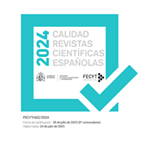Focus and scopus
Estudios sobre el Mensaje Periodístico (Studies about the journalistic message) (ISSN 1134-1629, ISSN-e 1988-2696) is a quarterly scientific journal. Its fundamental objective is to promote research into the expressive forms and social functions of journalism and communication. It publishes its articles in Spanish, although it also accepts collaborations in other widely disseminated languages such as English, French and Portuguese. EMP has three classic sections: "Studies" (monographic section dedicated to a topic of special relevance), "Research and documents" (section dedicated to works that meet the objectives of the magazine) and "Reviews" (presentation and criticism of works related to journalism or communication). The journal also publishes texts that the Editorial Board requests from prestigious authors (in the "EMP Essays" section) and some interviews with relevant personalities in the academic field of journalism or communication (in the "EMP Dialogues" section).
Posting frequency
Quarterly
interoperability protocols
Estudios sobre el Mensaje Periodístico provides an OAI-PMH (Open Archives Initiative – Protocol for Metadata Harvesting) interface that allows interoperability between different platforms and repositories through the exchange of metadata.
Protocol: OAI-PMH Version 2.0
Metadata formats: Dublin Core; MARC; MARC21; RFC1807
Route for harvesters: https://revistas.ucm.es/index.php/ESMP/oai
Magazine history
Estudios sobre el Mensaje Periodístico (Studies about the journalistic message) is one of the Spanish scientific journals with the longest history in the area of Journalism and Communication. Born in 1994 in the Department of Journalism I of the Facultad de Ciencias de la Información of Universidad Complutense de Madrid. Over the past 30 years, EMP has published 1,640 research articles and 300 literature reviews. Its pages have collected some of the best research in the areas of Journalism and Communication of these three decades.
Bernardino M. Hernando, professor of Journalism Writing, was the promoter of Estudios sobre el Mensaje Periodístico (EMP)in his first stage as editor-coordinator of the first three issues (1994-1997). In 1998, José Luis Martínez Albertos, professor of Journalism at Universidad Complutense de Madrid, assumed the presidency of the Editorial Board and María Jesús Casals, professor of Journalism at the same University, was named director/editor of the journal, a responsibility she held until her retirement in 2018. In her twenty years as director, Professor Casals led the great editorial and scientific development experienced by the publication, achieved its indexing in the main databases and turned EMP into one of the most prestigious journals in its area of knowledge.
The journal emerged with the objective of being a channel for scientific dissemination of the main research that has emerged in the area of Journalism, with special attention to the following fields, as indicated by Professor Martínez Albertos in number 4: 1) Expressive forms of the journalistic message (styles and genres); 2) Prominent modalities of contemporary journalism (interpretive journalism, investigative journalism, New Journalism...); 3) Content analysis of messages; 4) Organization of the professional work of journalists (style books, editorial statutes, deontological aspects...); 5) Action mechanisms of sources in news production. This initial thematic area would be modified at the end of the 90s with the incorporation of research work from the different communication sciences.
In the year 2000, the structure of the publication began, which is maintained to this day: a section called "Studies" (on a monographic topic), another called "Research and Documents" and a third called "Reviews", where reviews and presentations of books related to journalism are included.
Since 2001, the magazine has incorporated indexes and abstracts in English and deepened its internationalization process. EMP becomes one of the main references in the field of scientific publications in the area of Communication in Spain. The authors at the beginning of the century already came from a good part of Spanish universities and some from Latin America, in a trend that has remained constant since then with articles that come from practically all five continents. The journal currently has a high level of internationalization both in terms of its authors and the composition of the Editorial Board and the Scientific Board.
Since 2004, the journal has also been published in a digital version with open access (Open Access OA), thus clearly declaring itself in favor of open access to scientific literature through the Internet. All content is available free of charge at no charge to the user or their institution. Users may read, download, copy, distribute, print, search or link to the full texts of the articles, or use them for any other legal purpose, without seeking prior permission from the publisher or author. The default copyright license for its content is Creative Commons version 4.0. In 2017, its printed edition disappeared, appearing since then only in its digital version.
In 2011 the magazine became semiannual. Its international recognition began to become evident in those years, in which it became indexed in the Social Science Citation Index database, whose impact index, the JCR (Journal Citation Reports), is the most valued internationally. In those years it was also incorporated into Scopus, from the Elsevier publishing house, the most recognized in Europe, as well as in other reference databases for the indexing of scientific journals.
In 2019, the journal begins a new stage in which all editing and publication processes are carried out through the OJS (Open Journal System) platform. OJS is the most used open source platform in the management of scientific journals. Its periodicity becomes quarterly, in a first step (in 2019), and quarterly, starting in 2020. In this way, an attempt has been made to improve the efficiency of the editorial processes and shorten the times that elapse between carrying out research and the publication of the articles.









